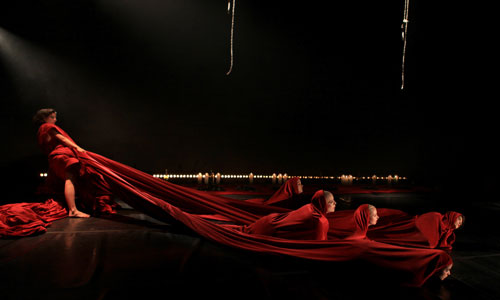Andréane Leclerc and “The Whore of Babylon” by Marion Gerbier
/ September 1, 2015
Version française...

Professional contortionist Andréane Leclerc is featured twice in the first edition of Grand CRU (Création Radicale Urbaine – Radical Urban Creation) this fall at Théâtre La Chapelle. Her full range of performance skills will be on display in La putain de Babylone (The Whore of Babylon), her newest creation combining circus arts, dance and theatre.
Creation, blasphemy and damnation lie at the core of the production. And of course, the Whore of Babylon, a multi-headed monster accused of prostituting the divine. At the center of it all lies the sacrosanct circus, a form with which Andréane strongly identifies. From a very young age the circus has been her language, her mode of expression, her way of seeing the world.
As with any vital force, Leclerc’s relationship to the circus is impassioned, love-hate. She has slowly distanced herself from her early experiences with the Cirque Éloize and with European cabarets. She believes that the modern circus is stuck in a world of impressive feats and has a narrow view of the spectacular.
“There is nothing spectacular about contortionism; it’s my way of moving. The circus is the most banal of things, a learned technique. The production turns it into something spectacular.”
When Leclerc began producing her own shows in 2009 — including Di(x)parue, which formed the foundation of her company, Nadère Arts Vivants — her need to break away from codes, conventions and traditions, and her desire to explore other art forms was affirmed.
During recent undergraduate studies in theatre, Andréane realized that she could move beyond the traditional use of drama in the circus. She left her troupe to work independently, mixing her repertoire of bodywork with classical texts and deconstructing the progression toward climax in favour of the immediate experience. The culmination of her research is Cherepaka, a new creation which — in addition to creating a great stir— provoked lively debate on its “circassian” nature during the latest edition of Montréal Complètement Cirque. While at university, Leclerc continued to perform in a wide range of venues: she was a guest speaker for Edgy Women, performed in a play revisiting Tchekhov by Angela Konrad, and appeared in choreographer Dave St-Pierre’s carte blanche EXV OTO for Danse Danse.
At the core of The Whore of Babylon lies a critical rebellion, nourished by meaningful collaboration. Inspired by “Babylon the Great, the Mother of Prostitutes and Abominations of the Earth”, as described by John in the Bible’s Book of Revelation, the project was developed alongside Martyn Jacques, lead singer of the Tiger Lillies. Scholar Sébastien Doane’s colossal body of research on biblical texts was an indispensable guide during the process. The cast of “eight whores, one being a god”, made up of actors and aerial performers, allowed Leclerc to concentrate on her role as director. Lighting, sound and costumes, the essential sculptural elements that work with the body on stage, were given special attention. “My colleagues taught me that chaos must be meticulously planned, just as the creation of something simple is actually quite complex.”
The production promises to be strongly visual and full of tangled complexity, steeped in images of hell by painter Hieronymus Bosch and writer Georges Bataille’s reflections mixed with eroticism and the sacred. “Lots of eggs. A river of broken glass. Whips.” The sulphurous nature of chapter 17 of the Book of Revelations stems more from the presence of bodies and the superimposition of perverted and ambivalent symbols than from the action. The stage, imagined in terms of underground levels, includes a low ceiling and velour curtains of imposing heaviness, both terrestrial gravity and the burden of guilt to be posthumously purged. This spatial restrictiveness is theproduct of residencies in diverse spaces where hanging anything was difficult to imagine. She colours the performance by limiting acrobatics and accentuating the precision of a vocabulary that is fundamentally oriented toward movement. It’s an affront to the usual exuberence of circus.
In addition to questioning the character of the circus spectacle, the relationship of audiences to achievement, and how dramatic theory relates to performance, Leclerc engages in a more personal struggle between her body and contortion, soul and image, echoing objectification in feminist thought. Her 2013 show Mange-moi was created in response to a request from Jade Marquis concerning feminine empowerment.
“Although La putain calls for a text of dramatic content, in which the body evokes different characters – we’re doing performance art that refers back to circus – the material of Mange-moi is more abstract and philosophical, closer to contemporary dance.” Grand CRU is reviving this short-form contortionism that is performed naked, fusing the sexual, the sensual, and the sensitive.
At the centre of this new, season-opening festival is Jack Udashkin, who will develop his last year of programming at the Théâtre La Chapelle before signing the direction over to the promising Olivier Bertrand. This will be an event that, in surpassing disciplinary boundaries, confirms the effervescence of the mutant art that is performance, and the plurality of his talents on stage.
Translation: Dayna Lamothe & Rebecca Anne Clark
Festival Grand CRU runs September 8 to October 3, 2015. – Théâtre La Chapelle www.lachapelle.org
Version française... | 
